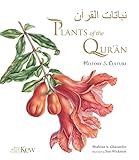When I first was a student volunteer at the Miller Library in the 1990s, I was struck by the several titles in the collection on the plants and flowers of the Bible. This was a popular subject, especially in the mid to later 20th century.
It is exciting that newer books are exploring the spiritual and cultural importance of plants for indigenous peoples, and in other sacred texts. The newest example is “Plants of the Qur’ān: History & Culture” by Shahina A. Ghazanfar. The book is richly illustrated by Sue Wickison, earning it an Award of Excellence for Botanical Illustration by the Council on Botanical and Horticultural Libraries in 2024.
 The text gives detailed accounts of the origins, history, and traditional uses of important plants to Muslims and other groups in western Asia and the eastern Mediterranean regions. Some of these plants, like ginger (Zingiber officinale, Zanjābīl in Arabic), have spread widely through human migrations from its native habitat in southeast, maritime Asia.
The text gives detailed accounts of the origins, history, and traditional uses of important plants to Muslims and other groups in western Asia and the eastern Mediterranean regions. Some of these plants, like ginger (Zingiber officinale, Zanjābīl in Arabic), have spread widely through human migrations from its native habitat in southeast, maritime Asia.
This introduced plant made a very favorable impression in early Islam: “Zanjābīl is mentioned once in the Qur’ān with reference to the final destination for the righteous and those who have done good deeds on earth, that they will be blessed with shaded gardens with fruit and a drink mixed with ginger.”
One of the most fascinating entries is the “Toothbrush Tree” (Salvadora persica; Khamț). This shrub or small, evergreen tree is found in Africa and western Asia. The fruit is considered inedible by most cultures, but the roots and small branches can be used for “cleansing and strengthening teeth, freshening the breath and preventing cavities.” Who needs toothpaste or mouthwash?
Reviewed by: Brian Thompson on May 20, 2024
Excerpted from the Summer 2024 issue of the Arboretum Bulletin